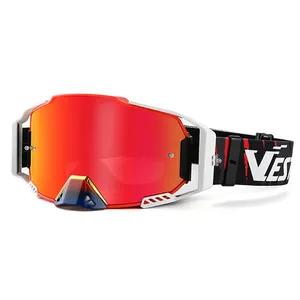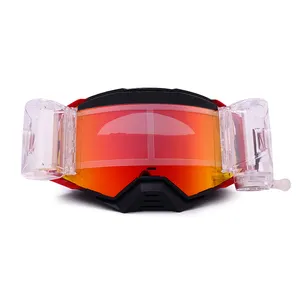
All categories
Featured selections
Trade Assurance
Buyer Central
Help Center
Get the app
Become a supplier

(198 products available)




















































MX goggles are important pieces of equipment for people who ride dirt bikes or do other kinds of motorcross sports. They help people see better while protecting their eyes from things like dust, debris, and branches. MX goggles are more than just safety glasses, though. They come in different styles, have special features, and are made with different materials, so everyone can find a pair that works well for them. Let's look at the most popular kinds of goggles and what makes them unique.
These goggles are designed to fit well without needing a tight strap. Instead, they use flexible materials or have different shapes to keep the goggles in place. This design offers a comfortable fit for long rides, as it doesn't dig into the head like some straps can.
Thermal mx goggles solve the problem of goggles fogging up during use. They work by putting a thin layer of air between two lenses. This layer keeps the temperature between the two lenses closer to the temperature outside, which helps prevent fogging. In other words, if the weather is cold or hot, the inner lens will always be at the same temperature as the outside lens to prevent fog. They will look like they are having bubbles between the two lenses, but this is normal and helps stop fog.
Mono mx goggles are different because they make one lens look nice instead of two. Using one lens makes it easier to see things when riding. Many modern materials can also block out UV light to protect the eyes from damage. The single lens design cuts out the frames between lenses to provide an uninterrupted wide view. This feature is good because when a rider looks around, they can see everything clearly without any frame blocks.
OTG mx goggles are special goggles that fit over regular glasses. They have extra space inside so the goggles can comfortably fit over prescription eyewear. OTG stands for "Over The Glasses," meaning these goggles let riders wear their glasses underneath without problems. The added room prevents goggles from pressing on glasses and ensures the rider can still see clearly through both sets of lenses.
MX goggles are most commonly used in off-road bike riding competitions and other extreme sports. However, beyond this typical application, some industrial scenarios also utilize these types of goggles. Here are a few examples:
In the construction industry, goggle mx clear can provide an extra layer of protection for workers operating heavy machinery. These goggles shield the eyes from dust particles, debris, and any small objects that may be dislodged during the operation of equipment on a work site. They also protect against hazards like concrete splashes or sparks from cutting and welding activities. Many types of mx goggles have features like anti-fog coatings or side ventilation that help minimize fogging, allowing workers to maintain clear vision even in warm, humid, or dusty conditions.
Goggles are extensively used in the mining industry. Miners are often exposed to a lot of dust, rock particles, and other potential eye hazards underground. MX goggles provide crucial protection from these hazards. MX goggles also help improve workers' comfort and safety, allowing them to focus on their tasks and reducing the risk of eye injuries.
Farmers also use these goggles when working with machinery like tractors and combines. When operating equipment or working in the fields, farmers may be exposed to dust, pollen, and flying debris from plants or equipment. MX goggles shield the eyes from these irritants, helping to prevent eye injuries and discomfort. Some goggles are also designed to reduce glare from the sun, giving farmers better visibility during outdoor work.
MX goggles are commonly worn in manufacturing facilities where workers operate machinery or handle various materials. In many production and assembly line jobs, workers are exposed to fast-moving components, tools, or the potential for airborne particles. The goggles protect against these hazards, ensuring the workers' vision remains safe while maintaining efficiency in their work tasks. They also keep the eyes safe from sparks, heat, and chemicals in welding, metalworking, and other industrial activities.
Lenses
The lenses used in goggle designs have a big job. They must let riders see well while also protecting their eyes from dangers like UV rays. Many lenses are tinted or mirrored to limit glare from the sun. Anti-fog technology stops lenses from getting cloudy when moving from heat to cooler air. Some brands have photochromic lenses that change tint based on light levels automatically.
Frame
The frame holds each part of the goggles together tightly. It contains the lenses and supports the entire structure. Frames need to be really strong but also flexible so they can bend without snapping. This is important when the goggles must be shaped to fit around a person's eyes and face.
Foam Padding
Soft foam padding on the inside of the goggles creates a snug seal against dirt and debris. This cushion also makes them comfortable to wear for long periods. The padding wicks away sweat, helping riders see clearly without interruption. Different densities of foam can provide a firmer or plusher feel, depending on personal preference.
Inserting the MX goggles is easy but should be done carefully. Riders should start by wiping any dirt or debris off the inside of the goggles and helmet where they will attach. This helps create a good, clean seal. Next, the flexible side pieces of the goggles should be bent gently. This makes them easier to slide into the mounting spots on the helmet.
Once the side pieces are bent, the goggles should be positioned just below the visor. The top straps should be attached to the front of the helmet first. Then, with the bottom held close, MX goggles should be adjusted so the lens sits at eye level and lines up with the helmet visor. Finally, the bottom strap should be secured behind the chin guard. The tension on both straps can then be adjusted until the goggles feel comfortably snug.
Before putting on the goggles, the rider should use a clean, soft cloth to wipe away any dust, dirt, or smudges from the lenses. This ensures an unobstructed view. Once the goggles are clean, the rider puts them on so the straps rest comfortably around the back of their head and under the helmet's chin. The straps should provide a secure but gentle hold without excessive tightness. The goggles should form a seal around the eye area without gaps. This prevents debris from getting inside. As the ride begins, periodic stops are made to check that the goggles remain in place and that vision is clear. Any dust that settles on the outside of the lenses can be gently brushed away with a clean glove or by hand.
Maintenance
MX goggles get dusty a lot, especially in off-road races. So, their outside must be cleaned well often. A soft fabric or brush works. Avoid sharp things that could scratch them. The lenses should be checked daily for signs of scratches, small cracks, or other damages.
Repairs
Repairing mx goggles at home is advantageous as it saves money. Some stores and online retailers offer lens repair kits. These usually include special stickers that cover small scratches or repairs, too. Occasionally, riders notice their foam padding is coming loose off the goggles. The adhesive should be applied carefully where it needs to stick back on. It is important that no adhesive touch the lenses.
Check for Damage
Before each race or ride, riders should inspect the goggles for any signs of wear. This includes cracks in the lenses, broken parts, or damaged straps. Any damaged goggles should be replaced right away. Safety goggles are designed to protect from injury, but damaged ones could allow dirt or debris into the eyes.
Secure Fastening
The strap should always fasten securely around the head. During practice laps or before a race, riders can shake their heads gently to ensure the goggles stay in place. If they bounce or move too much, adjust the strap tighter. Loose goggles may not block debris from getting into the eyes.
Proper Fit
The goggles should surround the eyes completely. Doing a quick check in a mirror can help confirm no gaps exist between the frame and skin. Even small spaces may allow tiny particles to slip inside. If any gaps are noticed, a different size or style mx goggles should be tried that provide better coverage.
Foam Padding
Foam padding should mold nicely around the eyes but still feel firm enough to provide a good seal. Riders can look for quality materials like 3-layer foam that wicks moisture to keep the goggles dry during a ride. This helps keep vision clear.
Testing Conditions
Manufacturers should rigorously test mx goggles in real riding conditions. This means taking them on dirt tracks, trails, and extreme weather. Tough environments reveal how well materials stand up to dust, impacts, and temperature changes.
Performance
Goggles should do the above tasks well. Riders can look for ratings on how well they block UV rays, resist fogging, and handle dust. Quality parts should ensure they perform the key tasks safely for a long time.
A1: MX goggles are designed specifically for off-road motorcycle riders. Their shape allows for better dirt and debris protection than regular safety goggles.
A2: Many riders find that investing in quality MX goggles enhances their vision and comfort prized during races. This makes them worth the cost.
A3: MX goggles should be regularly checked. They are replaced when any parts wear down or show damage, typically after a season of racing.
A4: By reducing fogging, they improve safety and comfort during races. This makes them a smart investment for many riders.
A5: Some goggles are made for riding with glasses. MX goggles that adhere to this function have extra space to fit prescription lenses.